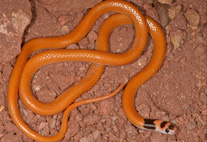Abstract
The genus Rhynchocalamus comprises three species distributed in Southwest Asia. Little is known about them, most probably because of their secretive fossorial lifestyle. The poor knowledge of the genus is even underscored by the fact that its phylogenetic affinities remained unclear until very recently. The least known of the species, Rhynchocalamus arabicus, is known only from the holotype collected in Aden, Yemen, and it has not been observed since its description in 1933. Here we provide a second record for this species, which represents the first record of this genus for Oman. This extends its range in southern Arabia by more than 1000 km. The observed specimen was determined as R. arabicus on the basis of its similarity in size, color, and scalation with the holotype. Furthermore, we sequenced three mitochondrial (12S, 16S, cytb) and one nuclear (cmos) genes for R. arabicus and for two individuals of R. melanocephalus and one R. satunini and inferred the phylogenetic relationships of all currently recognized species of the genus for the first time. The results of our phylogenetic analyses indicate that Rhynchocalamus is a member of the Western Palearctic clade of Colubrinae and is sister to Lytorhynchus, with which it forms a very well supported clade and shares some morphological characters. As our results show, R. satunini is the basal lineage of the genus and R. melanocephalus is sister to R. arabicus.

